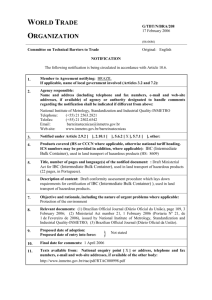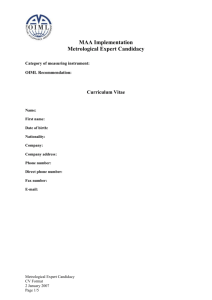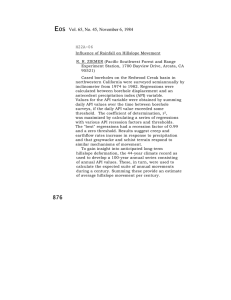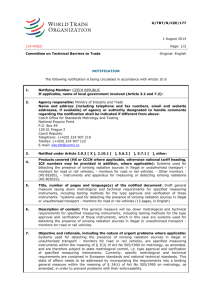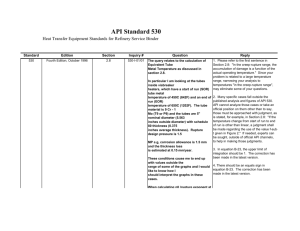FLOW COMPUTERS REGULATION IN BRAZIL: STATE OF THE ART AND... Renato Ferreira Lazari , Edisio Alves de Aguiar Junior
advertisement
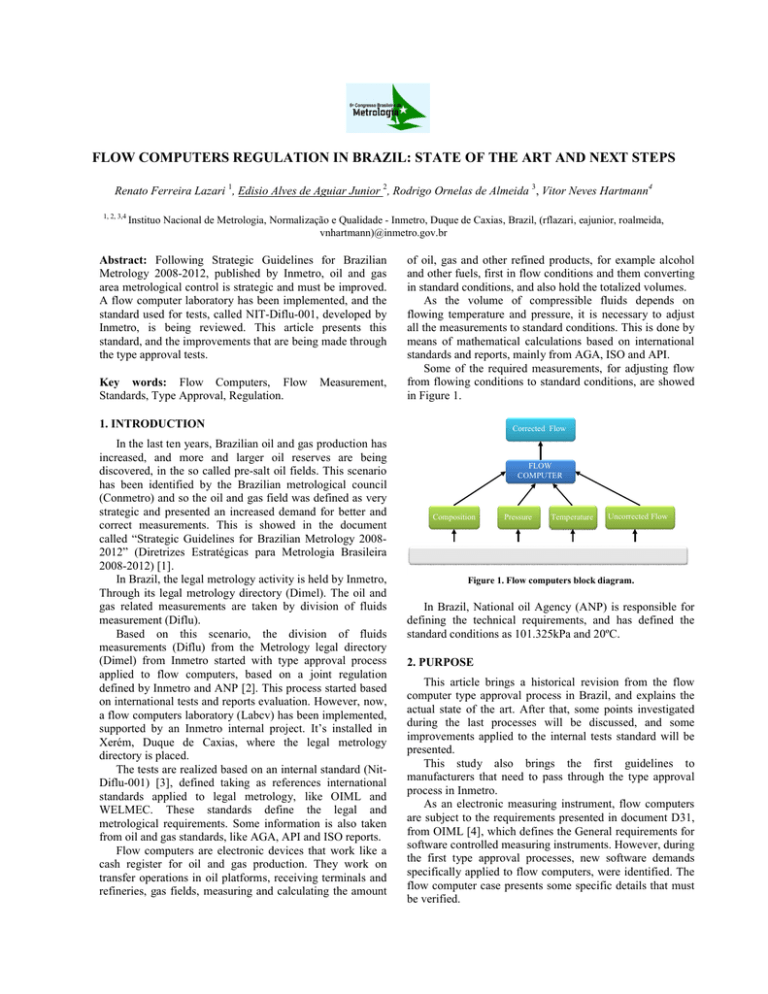
FLOW COMPUTERS REGULATION IN BRAZIL: STATE OF THE ART AND NEXT STEPS Renato Ferreira Lazari 1, Edisio Alves de Aguiar Junior 2, Rodrigo Ornelas de Almeida 3, Vitor Neves Hartmann4 1, 2, 3,4 Instituo Nacional de Metrologia, Normalização e Qualidade - Inmetro, Duque de Caxias, Brazil, (rflazari, eajunior, roalmeida, vnhartmann)@inmetro.gov.br Abstract: Following Strategic Guidelines for Brazilian Metrology 2008-2012, published by Inmetro, oil and gas area metrological control is strategic and must be improved. A flow computer laboratory has been implemented, and the standard used for tests, called NIT-Diflu-001, developed by Inmetro, is being reviewed. This article presents this standard, and the improvements that are being made through the type approval tests. Key words: Flow Computers, Flow Standards, Type Approval, Regulation. Measurement, of oil, gas and other refined products, for example alcohol and other fuels, first in flow conditions and them converting in standard conditions, and also hold the totalized volumes. As the volume of compressible fluids depends on flowing temperature and pressure, it is necessary to adjust all the measurements to standard conditions. This is done by means of mathematical calculations based on international standards and reports, mainly from AGA, ISO and API. Some of the required measurements, for adjusting flow from flowing conditions to standard conditions, are showed in Figure 1. 1. INTRODUCTION In the last ten years, Brazilian oil and gas production has increased, and more and larger oil reserves are being discovered, in the so called pre-salt oil fields. This scenario has been identified by the Brazilian metrological council (Conmetro) and so the oil and gas field was defined as very strategic and presented an increased demand for better and correct measurements. This is showed in the document called “Strategic Guidelines for Brazilian Metrology 20082012” (Diretrizes Estratégicas para Metrologia Brasileira 2008-2012) [1]. In Brazil, the legal metrology activity is held by Inmetro, Through its legal metrology directory (Dimel). The oil and gas related measurements are taken by division of fluids measurement (Diflu). Based on this scenario, the division of fluids measurements (Diflu) from the Metrology legal directory (Dimel) from Inmetro started with type approval process applied to flow computers, based on a joint regulation defined by Inmetro and ANP [2]. This process started based on international tests and reports evaluation. However, now, a flow computers laboratory (Labcv) has been implemented, supported by an Inmetro internal project. It’s installed in Xerém, Duque de Caxias, where the legal metrology directory is placed. The tests are realized based on an internal standard (NitDiflu-001) [3], defined taking as references international standards applied to legal metrology, like OIML and WELMEC. These standards define the legal and metrological requirements. Some information is also taken from oil and gas standards, like AGA, API and ISO reports. Flow computers are electronic devices that work like a cash register for oil and gas production. They work on transfer operations in oil platforms, receiving terminals and refineries, gas fields, measuring and calculating the amount Corrected Flow FLOW COMPUTER Composition Pressure Temperature Uncorrected Flow Flow Figure 1. Flow computers block diagram. In Brazil, National oil Agency (ANP) is responsible for defining the technical requirements, and has defined the standard conditions as 101.325kPa and 20ºC. 2. PURPOSE This article brings a historical revision from the flow computer type approval process in Brazil, and explains the actual state of the art. After that, some points investigated during the last processes will be discussed, and some improvements applied to the internal tests standard will be presented. This study also brings the first guidelines to manufacturers that need to pass through the type approval process in Inmetro. As an electronic measuring instrument, flow computers are subject to the requirements presented in document D31, from OIML [4], which defines the General requirements for software controlled measuring instruments. However, during the first type approval processes, new software demands specifically applied to flow computers, were identified. The flow computer case presents some specific details that must be verified. For example, the audit trail function, described in standard API 21.1 and API 21.2 [5], that records all the operations and parameters changes, must be verified in some way. Based on this, a revision about software requirements is proposed, based not only in OIML D31, but also in standards 21.1 (gas) and 21.2 (oil) from API, as showed in figure 2. and the primary device employed (Turbine, Orifice plate, etc.), and the tests are realized simulating electric signals, in the case of flow computers where pressure and temperature sensors are separated, called “Type 1” flow computers or with real physic signals, when these sensors are integrated to flow computer, in the so called “Type 2” flow computer. 4. TESTING PROCEDURES OIML D31 API 21.1 FLOW COMPUTERS API 21.2 Figure 2. Software Requirements. 3. METHODS When the joint document 001/2000 from ANP/Inmetro was first released, it brought the flow computers type approval requirement. The first flow computers were them approved based on international reports and approvations from other metrological institutes like NMI, PTB and Measurement From Canada. The process with the flow computers lab begun in Inmetro in April, 2010, when the first process and the first instrument have arrived for approval. After this point, the information available from other approvals were defined as references, but not enough for type approval. In this way, the specific requirements from Brazil, not present in other countries, could be tested. As measurement devices regulated by Inmetro, through joint regulation defined by ANP and Inmetro [2], the flow computers must be submitted to type approval and subsequent verification processes. The type approval methods were developed, based on international standards and recommendations, related to metrological aspects but also to oil and gas calculations. The standards related to metrological aspects come from OIML R117-1 for liquids (Dynamic measuring systems for liquids other than water, part 1: Metrological and technical requirements); AFNOR EN12405 for gas (Gas Meters – Conversion Devices) and documents D11 (General requirements for electronic measuring instruments) and D31 (General requirements for software controlled measuring instruments) from OIML [9, 4, 7, 10]. There are also standards related to gas and oil calculations, in this case, these standards and reports are from AGA, ISO, API and GPA. These standards depend upon the supported measurements and calculations realized by the flow computers. For example, the AGA Report number 7 [11] is applied when the flow computers supports turbine measurements. The information from these standards and reports is combined, according to the type of measurement (oil or gas) The procedures for testing flow computers began with the documentations checking. This is better described in the document NIE-Dimel-013 [6]. Verifying the documentation allows the technicians to define the necessary tests and estimate costs for the entire process. Not all of the flow computers work with all of the measurement standards, and because of this, the testing procedures and time necessary can be reduced or increased, depending on the presented requirements. Some legal aspects are worked in this moment and the documentation and process are submitted through the Orquestra System, available at http://orquestra.inmetro.gov.br. The so called orquestra system is the official way for submitting type approval processes, not only to flow computers, but also for any of the regulated measuring instruments. A full list of the instruments can be found at http://www.inmetro.gov.br/metlegal/instrumentosApreciaca o.asp. Each of them presents some documents requirements, and this information is also available at the referred site. After the documentation revision, the technical tests are initiated. The methods applied for testing the flow computers are described in an internal technical standard, called NIT-Diflu-001. The flow computer is classified in type 1 or type 2, depending on the associated measuring sensors. The type 1 flow computer is sold separately from pressure and temperature transducers, and the testing procedures are realized with 4-20 mA signals, generated with calibrated multicalibrators, as presented in Figure 3. Also, resistive signals can be simulated, through a resistive decade, depending on flow computers support to temperature resistive information. On the other hand, the type 2 flow computers are sold together with temperature and pressure transducer. In this case, it is not possible to send simulated signals, and physical data is obtained through a Dead Weight Tester and a dry oven, like the ones presented in Figure 4. The pulse inputs are also tested. This type of input is applied to meters whose output is supplied through pulses, like for example turbines and ultrasonic meters. The device must be capable of recognize and count the pulses. The limits are defined by the manufacturers, and some different waveforms are verified: sinusoid, square and triangle are verified, unless the manufacturer specifies something different. For realizing this test, electronic waveform generators are used. Today, two waveform generators are available at Flow Computers Laboratory. The purpose is using both of them for checking the pulse fidelity scheme. These procedures presented here are applied both to oil and gas cases. But some specific tests also apply. In the liquid case, the BSW calculation is verified. On the other hand, In the gas case, also the compressibility calculation is verified, according to AGA report number 8 procedures. Figure 3. Multicalibrator Device. also include the physical characterization of gas, density and compressibility factor (AGA 8) and also for liquids (API 11.1) As flow computers are electronic devices, they also must attend to requisites defined by OIML D31 (hasdgas). These tests are realized through accredited laboratories. After realizing the performance tests, described in OIML D31, a reduced set of tests, based on the initial ones is realized, for assuring that the disturbances did not change the metrological characteristics for the device. The generic software requirements are defined by OIML D11 [7]. Here, they are referred as generic, because there are some software requirements that apply only to flow computers. They are cited in API 21.1 (oil case) and API 21.2 (gas case). In the legal metrology case, the audit trail function was identified as very important. The audit trail records all changes in metrological relevant parameters, and also records the total production. As the flow computers operation depends upon connecting another measurement devices, the type approval is not enough for assuring the correct working for them. They are used as part of a measurement station, that normally consists on the flow computers, a primary instrument (turbine, orifice plate, ultrasonic meter) and secondary instruments (temperature and pressure measurements). These definitions comply with API 21.1. All of these measurement devices must be approved (primary devices) or calibrated (secondary devices). The correct measurements depend on attending the standards applied to the station. For example, working with a measuring station based on orifice plate measurements, which is calculated through ISO 5167 standard, brings specific requisites from the standard, that must be attended, like the minimum straight path. 5. IMPROVEMENTS Figure 4. Dead Weight Tester and Dry Oven. After the tests related to analog and pulse inputs, the flow computer is tested according to its conversion capacity, from flowing conditions to standard conditions. The calculations here are defined through international or national standards, and depend on the manufacturers specifications. A flow computer can be defined, for example, for working with only one type of measurement. The standards include secondary measurement devices (AGA 7 for turbines, AGA 3 and ISO 5167 for orifice plates and AGA 9 for ultrasonic meters), that are tested using simulated electric signals (4-20 mA and pulse signals); they During the tests, some possible improvements to the process were suggested, and are expected to be included in the type approval, through the internal standard Nit-DIflu001 [3]. The requirements present in OIML D31 [4], related to software, are verified by another division from Inmetro, called Ditel, responsible for holding these requirements to all kind of instruments. However, the flow computer’s software also should be compliant to specific requirements, presented by API 21.1 and API 21.2. Between these requirements, the audit trail testing must be included. The tests consist on changing the values, and verifying if the changes are recorded by the flow computer. The metrological parameters must all be tested. API 21.1 brings a suggestion about the main parameters, but working with API as a guide, other parameters can be added, if necessary. Another point identified for improvement is related to the totalizing function. As defined in API 21.1 and API 21.2, the flow computer must answer about the totalized production. Using pulse inputs, and a known number of pulses, the results can be predicted and compared to reference values. Also the scheme for pulse fidelity, described in ISO 6551, and cited in law 001/2000 from ANP/INMETRO, should be better tested. For assuring correct tests, it’s necessary to synchronize two pulse generators, and it is not possible to do in this moment, using the available waveform generators from the flow computers laboratory. Nowadays, the subsequent verifications process is not defined. As the type approval process is not enough for assuring that the instruments are developed in the same way as the first prototype, the initial tests must be defined and realized, by Inmetro or in some other way. 6. RESULTS As the main result, the metrological control is being applied to flow computers, what brings more confidence to the process. It should be noticed that the metrological control, when applied to flow computers, is not realized in the same way as other instruments: besides the type approval and verifications, also, the installation procedure must be approved and verified. This is required, because international standards bring specific requirements that must be attended for assuring correct measurements. Also, the associated measuring devices (pressure and temperature) must be calibrated. Although the electric simulated signals used in type approval are enough for checking the flow computer calculations, they are not enough for assuring that the installation will be done in the right way. The suggested improvements applied to current standards will bring still more confidence. The audit trail protection will provide the correct knowledge about the production. The metrological control, in scope of legal metrology, also is positioned as important for regulating the natural resources exploration, considered very important for the emerging countries to reach better positions. Making correct measurements also allows better information about the real oil and gas production. 7. CONCLUSIONS AND NEXT STEPS More and different ways of measurements, in the field of oil and gas, are used, studied and worked around the world. Environmental questions, like measuring processed water and CO2 emissions are coming into too. Today, Brazilian case is based on volume measurement, but there are other ways, like mass measurement or energy value, for the natural gas case. This is a discussion that probably will be held in next years, always trying to improve the metrological system and its effectiveness. The subsequent verification process is very important for checking the final product and also, in installation places, for verifying conformity to standards requirements, which are necessary for assuring correct calculations and measurements. This process can be treated as a “Measurement station approval”. Applying flow computers to other measurements outside from oil and gas industry (like oxygen and Hydrogen measurements) is also a question for future discussions, but currently not yet defined. The next steps, based on the positive experiences, includes working for verify more flow computers resources and requirements. Currently, the audit trail testing method is being developed, based on API 21.1 and API 21.2. The pulse fidelity, according to ISO 6551, has already a defined method, but until now it was not possible to acquire the synchronized signal generator. Both of the generators are available, but the tests could not be totally realized. Some new standards, like the Alcohol calculation, are being tested and will be included soon, according to market requests and demands. AKNOWLEDGMENTS The authors thank Inmetro for cooperation and financial support through the internal project, for implementing the flow computer laboratory. REFERENCES [1] Strategic Guidelines for Brazilian Metrology 2008-2012, available at http://www.inmetro.gov.br/metcientifica/dirEstrategica/diretr izesEstrategicas.pdf. [2] Inmetro/ANP law 001 from 2000 “Technical regulation applied to oil and gas”, available at http://www.inmetro.gov.br. [3] Internal Standard “NIT-Diflu-001”, rev. 1, available at http://www.inmetro.gov.br. [4] OIML D 31, 2008, General requirements for software controlled measuring instruments International Recommendation, available at http://www.oiml.org. [5] API MPMS 21, Flow Measurement Using Electronic Metering Systems, Chapter 1 and 2, First Edition, June, 1998. [6] Internal Standard “NIE-Dimel-013”, rev. 1, available at http://www.inmetro.gov.br. [7] OIML D 11, 2008, General requirements for electronic measuring instruments - International Recommendation, available at http://www.oiml.org. [8] AGA report number 8, “Compressibility Factors of Natural Gas and Other Related Hydrocarbon Gases”, second edition, 1992 [9] OIML R 117, 2007, Dynamic measuring systems for liquids other than water - International Recommendation, available at http://www.oiml.org [10] AFNOR NF EN 12405, Gas Meters Conversion Devices, First Edition, September, 2002 [11] AGA report number 7, “Measurement of Natural Gas by Turbine Meter”, third edition, 2006
